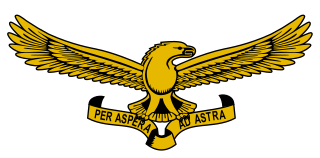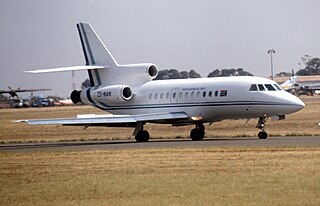
The Aermacchi or Macchi MB-326 is a light military jet trainer designed in Italy. Originally conceived as a two-seat trainer, there have also been single and two-seat light attack versions produced. It is one of the most commercially successful aircraft of its type, being bought by more than 10 countries and produced under licence in Australia, Brazil and South Africa. It set many category records, including an altitude record of 56,807 ft on 18 March 1966. More than 800 MB-326s were constructed between 1961–1975.

The South African Air Force (SAAF) is the air warfare branch of South African National Defence Force, with its headquarters in Pretoria. The South African Air Force was established on 1 February 1920. The Air Force has seen service in World War II and the Korean War. From 1966 the SAAF was involved in providing infantry support in a low intensity war in Angola, South-West Africa and Rhodesia. As the war progressed, the intensity of air operations increased until in the late 1980s, the SAAF were compelled to fly fighter missions against Angolan aircraft in order to maintain tactical air superiority. On conclusion of the Border War in 1990, aircraft numbers were severely reduced due to economic pressures as well as the cessation of hostilities with neighbouring states.

The Atlas Cheetah is a South African fighter aircraft designed and produced by the aviation company Atlas Aircraft Corporation. It was developed at the behest of, and principally operated by, the South African Air Force (SAAF).

2 Squadron is a squadron in the South African Air Force which was formed in 1940. The squadron has a long history, having been involved in every single combat action in which the SAAF has taken part. During the Second World War it made a name for itself in the battles for East Africa, before distinguishing itself in North Africa as part of the Desert Air Force, and later in Italy.

21 Squadron SAAF is a squadron of the South African Air Force. It was formed as a bomber squadron in Kenya during World War II and became a VIP transport squadron in the 1960s, a role which it performs to this day. The squadron currently flies two Dassault Falcon 50s, two Cessna Citation Is, a Dassault Falcon 900 and a Boeing BBJ aircraft. 21 Squadron is one of the most active squadrons in the air force with 606 VIP transport flights being made between 2009 and 2012. The Boeing BBJ is used as the presidential aircraft when the President of South Africa travels.

85 Combat Flying School is a unit of the South African Air Force (SAAF). It is a jet flight-training and combat operations school, it was first formed in 1982 at AFB Pietersburg. It relocated to AFB Hoedspruit on 1 January 1993 due to the closure of AFB Pietersburg. The school also has a wartime reserve role, although it has publicly been stated that the school will not be used operationally unless a very urgent need arises.

The Aermacchi AM.3 was the result of a joint venture between Aermacchi and Aeritalia in response to an Italian Army requirement for an aircraft to replace the Cessna L-19, and was initially designated the MB-335.

1 Squadron SAAF was an air force squadron of the South African Air Force and was formed at Air Force Station Swartkop in February 1920, equipped with De Havilland DH.9's part of the Imperial Gift donation to South Africa by Britain. On 31 August 1939 the squadron was re-designated as 1 Bomber/Fighter Squadron and this was then changed to 11 (Bomber) Squadron in December 1939. The squadron was resurrected in February 1940 by the renumbering of 6 Squadron, equipped with four Hurricane Mk 1's and six Furies.

Air Force Base Ysterplaat is an airbase of the South African Air Force. It is located in Cape Town suburb Ysterplaat, on the southwestern coast of South Africa. The name Ysterplaat is Afrikaans from the Dutch "Ijzerplaats" meaning "Iron Place" or "Place of Iron" in English.

AFB Durban is an airbase of the South African Air Force, located in Durban, KwaZulu-Natal, South Africa. The runway is shared with the Durban International Airport. The airbase is at the northern end of the runway.

5 Squadron SAAF was a South African Air Force Fighter / Fighter-Bomber squadron during World War II. It was disbanded at the end of the war and was re-commissioned in 1950. It remained active until 2 October 1992, when it was disbanded; its Atlas Cheetah E aircraft were also decommissioned.

12 Squadron was a South African Air Force squadron that served in the Second World War in East Africa and the Western Desert as a medium bomber squadron. After the war, the squadron was used in various roles, including that of a helicopter squadron until 1963, when it was equipped with Canberra light bombers, remaining a light bomber and reconnaissance squadron until disbanded in 1990.

102 Squadron is a reserve squadron of the South African Air Force. The squadron area of responsibility is from north of Polokwane (Pietersburg) to the Limpopo River and is used for reconnaissance flights along the South African and Zimbabwe and Botswana borders. The squadron is based at AFB Makhado in Louis Trichardt. These reserve squadrons are used to fill a pilot and aircraft gap within the SAAF by making use of civilian pilots and their privately owned aircraft. Most flying takes place over weekends and because pilots have a good knowledge of the local terrain in the area where they live and commonly fly, the squadron is used mostly in the reconnaissance and crime prevention role.

104 Squadron is a reserve squadron of the South African Air Force. This squadron is used mostly in the VIP/IP transport role as well as reconnaissance flights in the Gauteng area. The squadron is based at AFB Waterkloof. These reserve squadrons are used to fill a pilot and aircraft gap within the SAAF by making use of civilian pilots and their privately owned aircraft. Most flying takes place over weekends and because pilots have a good knowledge of the local terrain in the area where they live and commonly fly, the squadron is also often used in a crime prevention role.

105 Squadron is a territorial reserve squadron of the South African Air Force. The squadron operations include coastal reconnaissance, command and control and radio relay in crime prevention operations in co-operation with the South African Police and Army. The squadron is based at AFB Durban. These reserve squadrons are used to fill a pilot and aircraft gap within the SAAF by making use of civilian pilots and their privately owned aircraft. Most flying takes place over weekends and because pilots have a good knowledge of the local terrain in the area where they live and commonly fly, the squadron is mostly used in a crime prevention role.

31 Squadron was initially a World War II Coastal bomber/reconnaissance squadron South African Air Force. It was later converted to a heavy bomber squadron that operated from bases in the Mediterranean from January 1944 until the end of the war. On conclusion of hostilities, the squadron was used to ferry liberated POW's from Italy back to Britain and disbanded South African troops from Italy to Egypt. It was disbanded on 15 December 1945. It was resurrected as a medium and light helicopter squadron in 1982 and operated from AFB Hoedspruit until its final disbandment on 4 December 1992.

Air Force Station Port Elizabeth is a South African Air Force facility situated on the north-eastern side of the Port Elizabeth Airport main runway. It was downgraded from an Air Force Base in the early 1990s.
The History of the South African Air Force spans the First World War, Rand Rebellion of 1922, the Second World War, the Korean War, the South African Border War, and varied peacekeeping operations since 1994. Its battle honours include German South West Africa 1914–15, German East Africa 1915–1918, East Africa: 1939–1941, Middle East: 1941–43, Madagascar 1942, Italy 1943–1945, the Balkans 1943–1945, and Korea 1950–1953.

42 Squadron SAAF is a disbanded squadron of the South African Air Force, active from 1945 to 2000. The squadron's main role was to spot enemy artillery. The unit was formed in 1945 as 42 AOP Flight, flying Austers under command of an officer of the SA Artillery and was the only army aviation unit flying for South African forces during World War II.

The Air Force Mobile Deployment Wing (AFMDW) is a radar and communications wing of the South African Air Force. It provides combat ready, integrated and deployable air support capabilities. It appears to have sprung from the remnants of Airspace Control Command SAAF, which up until the late 1980s provided radar and warning functions. From the early 1950s, 1, 2, and 3 Satellite Radar Stations were formed at Mariepskop, Ellisras, and Mafiking, along with 70 Mobile Radar Group.



















